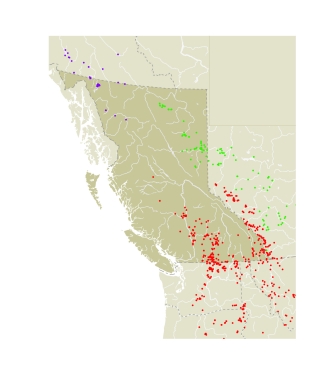AdultCommon Alpines have two to four large orange patches on each dorsal forewing, which are frequently fused. Within the orange patches are up to four black spots, frequently with white centres. They are the only alpine with well-developed eyespots on the hindwings. In all populations there is a great deal of variation in the number and size of dorsal and ventral submarginal eyespots on both the forewings and hindwings. In all subspecies, specimens from alpine populations are smaller and the eyespots are reduced or absent.
Immature StagesImmature stages of the nominate subspecies, epipsodea, were described by Edwards (1887-97), and of subspecies sineocellata by Lyman (1896). Eggs are round, slightly taller than wide, with 22 vertical ribs, and white in colour. First instar larvae have large pale brownish heads, pitted with dark depressions and with brown spots. There is a brown stripe down the back, and the body is green white (epipsodea) to pale tan (sineocellata), with three (epipsodea) to five (sineocellata) brown stripes on each side. Dorsal, subdorsal, and lateral rows of blackish tubercles run along the body, and there are two short tails at right angles to each other. Mature larvae are greenish brown (sineocellata) to delicate yellow green with a greener underside (epipsodea). There is a dark brown stripe down the back bordered by a creamy yellow stripe on each side. Halfway down each side there is a creamy yellow stripe, with a brown line along the lower edge, and another creamy yellow line along the side just above the spiracles (sineocellata). The basal ridge is greenish (epipsodea). There are two short tails at right angles to each other. The head is pale yellow brown and covered with brown pits. Pupae are pale brown with dark brown markings and orange spiracles (sineocellata), or white brown with brown yellow and brown markings, 11-12 black longitudinal streaks on the wings, brown lines at the junction of the abdominal segments, and dorsal and lateral lines of black dots on the abdomen (epipsodea).
SubspeciesThe nominate subspecies, TL: Rock Lake, near Jasper, AB (Kondla 1996), occurs throughout southern and central BC. The dorsal orange patches are dull orange with poorly defined boundaries. The ventral hindwing of males is generally evenly dark brown, or with the outer third only slightly lighter than the rest; spots are rare. At high elevations the markings are reduced in size. Subspecies sineocellata Skinner, 1889 (TL: near Fort Qu'appelle, SK) is a prairie subspecies occurring in the Peace River of BC. The orange patches on the upperside of the wings are bright orange with well-defined boundaries. In the ventral hindwing of males, the outer third is much greyer than the rest, and spots are usually present. Subspecies remingtoni P. Ehrlich, 1952 (TL: Dawson, YT) occurs in northwestern BC. The dorsal orange patches are well developed, with moderately well defined boundaries. The spots within the orange patches are small, with the hindwing frequently missing all spots and the forewing normally with only two to three spots. The ventral ground colour is relatively even. Subspecies freemani Ehrlich, 1954; TL: restricted to the vicinity of Rivercourse, AB (Kondla 1996), is a synonym of subspecies sineocellata. Contrary to the opinion of Ehrlich (1955) and others, Skinner described sineocellata as a geographic variety, not as an aberration, and therefore Ehrlich's replacement name was unnecessary. Subspecies hopfingeri Ehrlich, 1954 (TL: Black Canyon, Okanogan Co., WA) is a synonym of the nominate subspecies. The hopfingeri phenotype is the low-elevation form of E.e. epipsodea.
